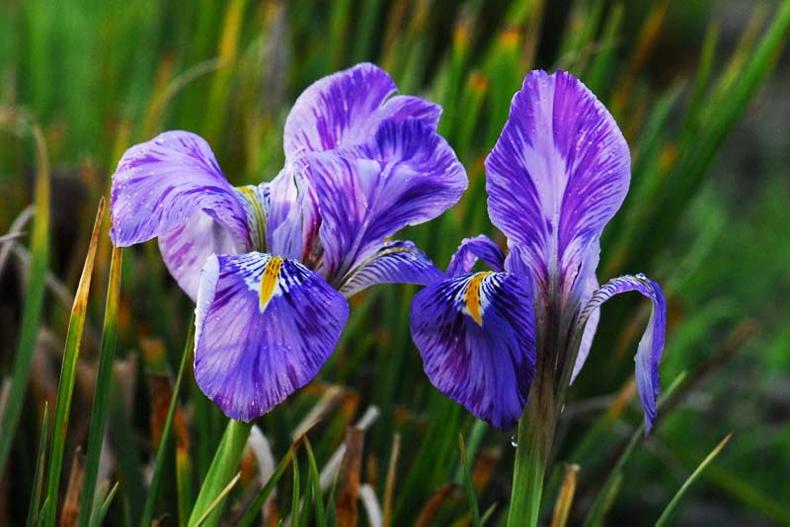Name: Winter iris, Algerian iris
This charming iris species has the unusual trait of flowering in winter, hence the common name. It grows in Algeria and it is often known as the Algerian iris.
Botanical name: The botanical name of the winter iris is iris unguicularis. It used to be known (and sometimes still is) as iris stylosa, a reference to the style or female part of the flower.
The name change to iris unguicularis, was regretted by many fans of this lovely flower as the new name is undoubtedly more difficult to remember. But when you observe the flower, the new name makes sense.
The specific name unguicularis means like a hand-nail or claw, like the feet of a bird. In this case, it refers to an appendage to the base of the petals, shaped and pointed like a claw.
Family: As might be expected, being part of a large family of decorative plants, iris has its own family, the iris family, iridaceae. This species has typical iris flowers with three standard petals and three fall petals.
Iris species have storage systems in the form of bulbs or rhizomes to ensure that the plant gets through winter and has enough energy to produce large iris flowers.
Garden value
The winter iris bucks the trend of the vast majority of garden flowers which have shut up shop for winter, withering back to survive the harsh weather. The winter iris is one of the most beautiful flowers, as colourful and large as any summer iris, and yet it flowers in winter.
The flowers are an exquisite pale lavender-blue with a clear bar of yellow on the lower petals and a pattern of dark-blue veins spreading down the lips of the flower. The petals have a luminous quality, charming on a winter’s day.
To see it in all its beauty on a winter day is to be smitten and then you want to grow it. Once planted, it will grow away nicely and make a fine clump of grassy leaves about half a metre across.
But no flowers appear, at least in the early years. Sometimes you might have to wait five years.
Wisely, the flowers are held down amid the twisting grassy leaves, not high and clear of the foliage like most iris species. As a result, the flowers cannot be seen easily – usually it is necessary to walk up close to the plant and to look down amid the foliage to spot the flowers.
The flowers have a habit of appearing erratically between autumn and spring and there will be many a wasted visit.
But the reward of finding a few flowers open is very satisfying, and no matter how often you see the flowers year after year, they are always a delight.
The contrast between the delicate beauty of the flowers and the rough, half-withered foliage is dramatic but, far from spoiling the appearance of the flower, this merely adds to its charm.
Growing winter iris
Almost any mild spell between autumn and spring will encourage a few flowers to open. The flower opens from a protective sheath and unfolds in the space of a couple of warm days.
The flower is quickly pushed out of its bud by a long, translucent white tube to take advantage of the good weather. Once the clump is established, leave it alone.
Given its provenance, it is not surprising that it thrives in a sunny position in well-drained soil. A south-facing wall is the best place to plant it so that it gains some extra warmth and the wall acts like a heat store.
Although it likes well-drained soil and a sunny position, it grows poorly in shallow soil that is too dry. While it does best in soil that is not rich, it does not respond well to being starved either.
Work in some very old compost into the soil when planting and add some coarse sand or gravel. It is easy enough to grow – all you need is patience!

Colourful chrysanthemums bring joy to the winter garden.
Chrysanthemums are one of the latest flowers to bloom in the late autumn and early winter. These are usually sold in pots already in flower and ready for planting out in the garden or in a container or simply as a houseplant.
These are mostly the types that cover themselves with masses of the small flowers. The flowers are long-lasting for several weeks, but eventually the flowers fade and wither away.
Hybrids have been created, mostly as cut flowers to be used for a few weeks and discarded. Instead of discarding chrysanthemums that you may have bought with this in mind, why not plant them out in a bed or border where there is a gap with reasonably good soil and some shelter?
Some hybrids are not hardy enough to withstand winter weather. But some kinds might be, and these survive to flower again. If they sprout new shoots in spring, cut back old stems. Some kinds might turn out to be tall but trimming in June will reduce the height.
Flowers
It is not too late to put a few flowers in pots, especially near the front door and in time for the festive season. Otherwise, perennial flowers can be planted, or lifted, divided and re-planted if they have grown too big.
Trees and shrubs
Plant shelter belts, hedges, and woodland areas, the ideal is to plant small bare-root whips or transplants. These are relatively cheap to buy, establish well and are easily planted. Move deciduous trees or shrubs.
Fruit, vegetables and herbs
Fruit trees and bushes of all kinds are available now and can be planted immediately. An excellent choice of varieties is available to choose from. Lift any remaining root crops and store them in a suitable shed or pit.
Lawns
Do not walk on lawn areas if they have become soggy, for fear of causing soil compaction, but if the weather is good and the ground firm, the grass should be mowed, or it will be difficult to mow next spring.
Greenhouse and house plants
A greenhouse can be used to grow early vegetables. For instance, an early variety of carrots can be sown even in December to give a crop of fingerling carrots in May. Early crops of cabbage and cauliflower can be started too.
Read more
Gardening with Gerry Daly: Brooding autumn hues
Gardening: festive foliage, foraging and bird-watching
Name: Winter iris, Algerian iris
This charming iris species has the unusual trait of flowering in winter, hence the common name. It grows in Algeria and it is often known as the Algerian iris.
Botanical name: The botanical name of the winter iris is iris unguicularis. It used to be known (and sometimes still is) as iris stylosa, a reference to the style or female part of the flower.
The name change to iris unguicularis, was regretted by many fans of this lovely flower as the new name is undoubtedly more difficult to remember. But when you observe the flower, the new name makes sense.
The specific name unguicularis means like a hand-nail or claw, like the feet of a bird. In this case, it refers to an appendage to the base of the petals, shaped and pointed like a claw.
Family: As might be expected, being part of a large family of decorative plants, iris has its own family, the iris family, iridaceae. This species has typical iris flowers with three standard petals and three fall petals.
Iris species have storage systems in the form of bulbs or rhizomes to ensure that the plant gets through winter and has enough energy to produce large iris flowers.
Garden value
The winter iris bucks the trend of the vast majority of garden flowers which have shut up shop for winter, withering back to survive the harsh weather. The winter iris is one of the most beautiful flowers, as colourful and large as any summer iris, and yet it flowers in winter.
The flowers are an exquisite pale lavender-blue with a clear bar of yellow on the lower petals and a pattern of dark-blue veins spreading down the lips of the flower. The petals have a luminous quality, charming on a winter’s day.
To see it in all its beauty on a winter day is to be smitten and then you want to grow it. Once planted, it will grow away nicely and make a fine clump of grassy leaves about half a metre across.
But no flowers appear, at least in the early years. Sometimes you might have to wait five years.
Wisely, the flowers are held down amid the twisting grassy leaves, not high and clear of the foliage like most iris species. As a result, the flowers cannot be seen easily – usually it is necessary to walk up close to the plant and to look down amid the foliage to spot the flowers.
The flowers have a habit of appearing erratically between autumn and spring and there will be many a wasted visit.
But the reward of finding a few flowers open is very satisfying, and no matter how often you see the flowers year after year, they are always a delight.
The contrast between the delicate beauty of the flowers and the rough, half-withered foliage is dramatic but, far from spoiling the appearance of the flower, this merely adds to its charm.
Growing winter iris
Almost any mild spell between autumn and spring will encourage a few flowers to open. The flower opens from a protective sheath and unfolds in the space of a couple of warm days.
The flower is quickly pushed out of its bud by a long, translucent white tube to take advantage of the good weather. Once the clump is established, leave it alone.
Given its provenance, it is not surprising that it thrives in a sunny position in well-drained soil. A south-facing wall is the best place to plant it so that it gains some extra warmth and the wall acts like a heat store.
Although it likes well-drained soil and a sunny position, it grows poorly in shallow soil that is too dry. While it does best in soil that is not rich, it does not respond well to being starved either.
Work in some very old compost into the soil when planting and add some coarse sand or gravel. It is easy enough to grow – all you need is patience!

Colourful chrysanthemums bring joy to the winter garden.
Chrysanthemums are one of the latest flowers to bloom in the late autumn and early winter. These are usually sold in pots already in flower and ready for planting out in the garden or in a container or simply as a houseplant.
These are mostly the types that cover themselves with masses of the small flowers. The flowers are long-lasting for several weeks, but eventually the flowers fade and wither away.
Hybrids have been created, mostly as cut flowers to be used for a few weeks and discarded. Instead of discarding chrysanthemums that you may have bought with this in mind, why not plant them out in a bed or border where there is a gap with reasonably good soil and some shelter?
Some hybrids are not hardy enough to withstand winter weather. But some kinds might be, and these survive to flower again. If they sprout new shoots in spring, cut back old stems. Some kinds might turn out to be tall but trimming in June will reduce the height.
Flowers
It is not too late to put a few flowers in pots, especially near the front door and in time for the festive season. Otherwise, perennial flowers can be planted, or lifted, divided and re-planted if they have grown too big.
Trees and shrubs
Plant shelter belts, hedges, and woodland areas, the ideal is to plant small bare-root whips or transplants. These are relatively cheap to buy, establish well and are easily planted. Move deciduous trees or shrubs.
Fruit, vegetables and herbs
Fruit trees and bushes of all kinds are available now and can be planted immediately. An excellent choice of varieties is available to choose from. Lift any remaining root crops and store them in a suitable shed or pit.
Lawns
Do not walk on lawn areas if they have become soggy, for fear of causing soil compaction, but if the weather is good and the ground firm, the grass should be mowed, or it will be difficult to mow next spring.
Greenhouse and house plants
A greenhouse can be used to grow early vegetables. For instance, an early variety of carrots can be sown even in December to give a crop of fingerling carrots in May. Early crops of cabbage and cauliflower can be started too.
Read more
Gardening with Gerry Daly: Brooding autumn hues
Gardening: festive foliage, foraging and bird-watching










SHARING OPTIONS